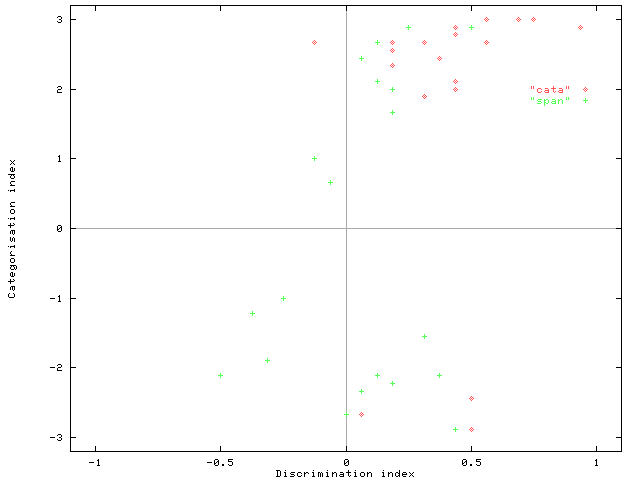
The paper is available in pdf or postscript formats.
We provide here some figures which were not included in the original paper for reasons of space, and that show the data in more details.
Abstract
It is well attested that we perceive speech through the filter
of our native language: a classic example is that of Japanese
listeners who cannot discriminate between the American /l/ and
/r/ and identify both as their own /r/ phoneme (Goto, 1971).
Studies in the laboratory have shown, however, that perception of
non-native speech sounds can be learned through training (Lively,
Pisoni, Yamada, & Tohkura, 1994). This is consistent with
neurophysiological evidence showing considerable
experience-dependent plasticity in the brain at the first levels
of sensory processing (Edeline & Weinberger, 1993; Kraus, et
al., 1995; Merzenich & Sameshima, 1993; Weinberger, 1993).
Outside of the laboratory, however, the situation seems to
differ: we here report a study involving Spanish-Catalan
bilingual subjects who have had the best opportunities to learn a
new contrast but did not do it. Our study demonstrates a striking
lack of behavioral plasticity: early and extensive exposure to a
second language is not sufficient to attain the ultimate
phonological competence of native speakers.
These parameters were selected from goodness ratings obtained in a pilot work for synthetic vowels in the /e/-/E/ region of F1-F2 space.
Here are the stimuli:
Fig. 1 Categorization of the /closed-e/-/open-e/ continuum (grouped results).

To assess individual variability we computed, for each subject, a "categorization indice", defined as "p7+p6+p5-p1-p2-p3" where pi=Prob(resp="pera" / stim=si).
Fig 1bis (not included in the paper) Histograms of categorization indices for Spanish (red) and Catalan (blue) subjects.
Fig.2: Discrimination of vowel pairs (Grouped data).

To assess individual variations, we computed, for each subject, a discrimination indice defined as "p3-(p1+p5)/2" where pi is the score on the ith pair.
Fig 2bis (not included in the paper) Histograms of discrimination indices for Spanish (red) and Catalan (blue) subjects.


The correlation between the two tasks is significant (r2=.16; t(38)=2.7; p=.01)
Comment: It is clear from these histograms that there was an overlap between the performances of the Spanish-born and the Catalan-born subjects. Thus, one must not conclude from our paper that it is impossible for a second language learner to reach the performance of a native speaker. The difference between the two sub-populations is nevertheless remarkable.
We provide the file with individual data (excel format, text format) for those interested in further analyses. Email-me if explanations are needed.